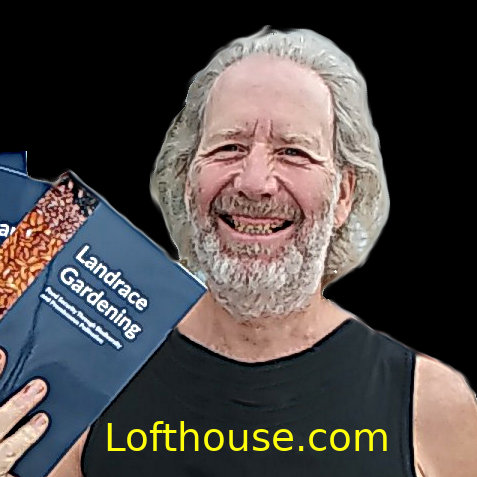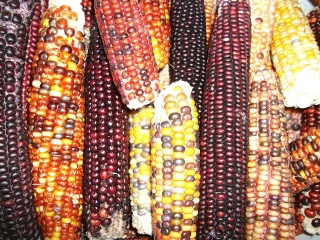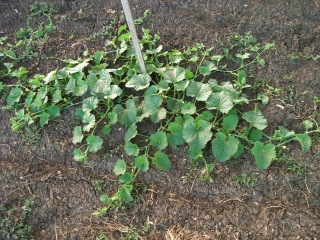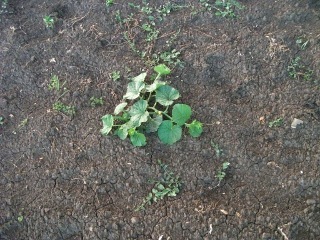

[ Articles ]
[ Seed List ]
[ Bio ]
[ Buy my book]
  |
[ Media ] [ Articles ] [ Seed List ] [ Bio ] [ Buy my book] |

Definition
Adaptation agriculture is an intimate relationship between a location, a farmer, and a population of genetically-diverse seed. An adaptivar landrace is a foodcrop containing lots of genetic diversity which tends to produce stable yields under marginal growing conditions. Landrace crops are adaptively selected via farmer choice and survival-of-the-fittest for reliability in tough conditions. The arrival of new pests, new diseases, or changes in cultural practices or in the environment may harm some plants in a landrace population, but with so much diversity many plants are likely to do well under the changing conditions.In the case of mostly self-pollinating plants like peppers, tomatoes, beans, wheat, and peas a landrace may be thought of as many distinct varieties growing side by side.
In the case of out-crossing plants like cantaloupe, squash, or corn, a landrace can be thought of as an open pollinated population with tremendous genetic diversity. Most of the seeds in an out-crossing landrace end up being unique F1 hybrids.
| "Landrace: A variety or collection of interbreeding varieties that were developed in a specific location with selection based more or less on survival of the fittest for that location." Johno |
History
For 10,000 years agriculture thrived by growing genetically diverse seeds.About 60 years ago large corporations started breeding crops so that huge harvests of identically sized and colored produce could be picked on the same day. They did this primarily through inbreeding and application of chemicals: discarding most of a species diversity, and then spraying the heck out of it with pesticides, herbicides, and fertilizers to compensate for the problems caused by the intense inbreeding. It is rare for a home gardener to be able to stick to the strict spray schedules required to get the best yield out of highly inbred crops. Small market farmers, organic growers, and individual gardners are generally better off growing variable sized produce that ripens over a few weeks or months, and that doesn't require perfect weeding and carefully timed applications of fertilizers and pesticides. Due to the high genetic diversity of landrace crops, there are likely to be some family types in a population that will thrive in a home garden in spite of marginal growing conditions, weather, pests, or less than ideal weeding.
Historically, many famines have been caused by the failure of a single inbred or cloned crop due to the appearance of a new pest or disease; examples include: The European potato pestilence of 1845-1857, the southern corn rust in Africa in the 1950s, the American corn blight of 1970, and more recently the GMO corn failure in South Africa in 2009. Many of the crops grown by the Anglosphere are highly inbred and are succeptible to massive crop failure due to the appearance of a new pest or disease, or to a disruption in normal weather patterns, cultural practices, or spray schedules.
I believe this inbreeding is primarily due to the politics of western society over the last century: using government to concentrate more and more power into larger and larger organizations. The seed laws, business licensing, the tax code, and the public school system all create a strong bias against planting genetically diverse garden seeds. The way to counteract the effect of this trend is to become responsible as individuals, families, and communities for our own localized seeds: To grow our own seeds and trade them among each other even if they have been declared illegal or unstable.
I believe that the western world's recent enfatuation with growing clones and inbreds is prone to failure. It only takes one new pest, or one new disease to wipe out a highly inbred variety, which are often highly dependent on synthetic herbicides, pesticides, and fertilizers. Any disruption in the application schedule, can ruin the crop. It is much more difficult for a new pest or a change in weather to wipe out the hundreds or thousands of genotypes that might exist in a landrace. (On my farm I grow about 5000 genotypes of sweet corn.) As oil and the agrochemicals (and monetary systems) derived from it become more expensive and less readily available I expect landrace farming to become more common.
| "Yield stability of landraces under traditional low input agricultural systems is due to the fact that whatever the varying biotic and abiotic stress for each plant one or more genotypes within the landrace population will yield satisfactorily. Landraces were and still are grown by farmers, market and private gardeners all over the world for this reason." Euphytica 104: 127–139, 1998. © 1998 Kluwer Academic Publishers. Printed in the Netherlands. Landraces: A review of definitions and classifications A.C. Zeven |
Continuous Improvement
The greatest benefit that I have noticed on my farm from growing landraces and saving my own seed is that my crops thrive. When I buy a variety from Oregon, or Iowa, or Walmart I never know how it will do in my garden: seeds with different genetics can even carry the same label. But if I plant three or four varieties and save the seeds from the individual plants that grow best for me, I end up after a few years of survival-of-the-fittest and farmer-directed selection with plants that do really well, and that are reliable year after year. I specifically mention Oregon because much of the organic vegetable seed sold to home gardeners in the usa is grown in Oregon, with it's damp, rainy, overcast weather. When my neighbors plant that seed in their gardens it burns up because it has not been adapted to our super aridity and brilliant sunlit days.Less Stress
By growing my own land-race seeds I eliminate all sorts of stresses. I don't have to worry about paying for seeds. I don't have to keep pedigrees or records. (Most of our current crops were developed by illiterate peasants.) I don't have to keep seeds pure. I can save seeds from hybrids. I don't get out of kilter when the seed catalog drops my favorite variety. I don't have to worry about whether or not I will get a harvest.Modern inbred varieties rely on poisons for crop protection. Landraces do it via genetic variability.
|
"In essence, my landraces are a type of 'crop insurance'
by maintaining diversity I maintain my ability, even
in the worst years to produce a crop for home or
market use with out relying on the government and
their regulations or on a insurance corporation to cover my ass."
Alan Bishop -- Homegrown Goodness |
Better Flavors
I taste every plant or fruit before saving seeds from it. This has resulted in selection for plants that are extremely pleasing to my personal taste buds. Sometimes when I import seeds from far away into my garden I am horrified that people actually grow and eat such bland tasting foods.
Open Pollinated or Heirloom vs Landrace
Seeds are sometimes described as being 'heirloom' or 'open pollinated'. These varieties can be highly inbred, often having originated from a single seed. Heirloom and open pollinated varieties may also be genetically diverse, but they are seldom as diverse as a landrace. The term 'open pollinated' is most typically used to mean that every trick known to mankind was used to prevent the variety from actually being pollinated by anything else. I typically think of the out-crossing species in my garden as being 'promiscuously pollinated'. That approaches the plain and simple meaning that 'open pollinated' was intended to imply.
| "A landrace is a variety that has been purposely maintained as a diverse gene pool to help it be more adaptive to harsh conditions." AdaptiveSeeds.com 2012 seed catalog. |
Creating a Landrace
To western peoples access to traditional landrace crops is extremely limited, so it is often necessary to create our own. The method most commonly used is to plant approximately equal amounts of seed from several different sources and varieties. We recomend using heirlooms, open pollinated varieties, and appropriately screened hybrids. It is common to plant together the seeds from 5-50 varieties to make the original mass cross. The seeds produced by this mass cross are the beginnings of a new landrace. With the first harvest of seed, and in the following years the landrace is tailored to each garden and to each region by survival-of-the-fittest and farmer-directed selection. Landraces that have been selected to thrive in my arid very sunny high-altitude garden grow much better for me than typical off-the-shelf seeds that were produced in humid semi-overcast regions. Sometimes as many as 100-200 varieties are planted, which may turn into hybrid swarm breeding if multiple species, or extremely diverse phenotypes are included.Maintaining an adaptivar LandraceWhen creating a landrace we include seeds that are available from individuals via the free market (blogs, online auction sites, open source seed breeding projects, local gardeners, seed swaps). Seeds grown by your neighbors and your local farmer's market are included if possible since they are already a year or more ahead in adapting to local conditions. Due to cytoplasmic male sterility we recommend that hybrids not be used in the creation of landraces for the following crops: carrots, cabbage, broccoli, onions, beets, potatoes. The following species are generally considered safe even if hybridized: spinach, cantaloupe, squash, tomato, beans, peas. Even open pollinated and heirloom crops have been contaminated by cytoplasmic male sterility. We recomend that all landrace crops be screened routinely to eliminate male sterility. The screening in many species is as simple as looking at the flowers and culling any plants that lack anthers or pollen.
Landrace crops may also be developed gradually. For example by saving the seeds from whatever you happen to be growing this year, planting the collected seeds, and also planting a new variety in the next row over. Then if the new variety grows well saving the seed from that and adding it to your population.
I consider it my duty as a farmer to maintain healthy and thriving adaptivar populations for the crops that are most desired by the people that I feed. My protocol for doing so is:
- Add small amounts of new genetics to the genepool from time to time.
- Include a small amount of 2 and 3 year old seed in each year's planting.
- Grow a sufficently large population to maintain genetic diversity.
- Be liberal during selection: for example by saving fruits of different sizes, shapes, colors, textures, flavors, and maturity dates.
- Swap seeds with the neighbors to enhance local adaptability.
| Without synthetic inputs, the true strengths or frailties of a cultivar become clear. Wild Garden Seed Catalog, 2009 |
Example
I planted around 90 different varieties of cantaloupe over a three year period. They came from my farm, the surrounding farms, and the Internet. I planted the first packet of seed, and then the next packet, etc without keeping track of which varieties went where until the whole field was planted. Some varieties were entirely destroyed by soil microorganisms before they germinated. Some varieties were entirely eaten by bugs before they were an inch tall. Some varieties grew slowly and didn't produce a fruit in my garden. Many varieties grew passably and produced fruit by the time the plants were killed by frost. A few individual plants grew vigorously, and produced lots of fruit, and some fruit ripened weeks before first frost. A collaborator in my valley did the same thing in her garden. We swapped seeds over the years. We saved seeds from the best producing and the earliest cantaloupes. We called it "Lofthouse-Oliverson Landrace Muskmelon". I also save seeds occasionally from off-type fruits just in case some new clever cantaloupe shows up due to all the cross-pollination that is going on. For example, after 6 years some extra-large fruits showed up. Their ancestors had contributed pollen early on, but not made fruits. Also some 'bush' cantaloupes showed up. They may become separate landraces.


Cantaloupe not well adapted to my fields
Obtaining Seeds
Due to the currently strange economic conditions, I am not selling seeds. Some varieties of my seeds can be obtained from:
-----
After my book came out, requests poured in for varieties mentioned in the book. It takes me at least an hour per request to handle the correspondence, find the seed, package it, and get it to the post office. If you ask me directly for seed, or information about varieties, please consider making a donation large enough to cover an hour or two of a celebrity's time.
| ... "farmers who want to honor their plurality of values, minimize risk, and maximally fulfill their needs will plant a diversity of landrace populations that are internally diverse." Landrace Agriculture as an Expression of Pluralistic Values, Jake Wartell |
My landraces
Landrace garden cropsAdditional Reading
Here are links to articles I wrote about Landrace Gardening. The most current list is available from Mother Earth News.Joseph Lofthouse, seedsman from Paradise Utah, is now blogging about “Landrace Gardening” on Mother Earth News. The blog is a practical hands-on manual about how to improve crop production by localizing your plants to your unique garden.Survival of the FittestA photo essay showing off the stunning success of landrace gardening on my farm. This success was achieved because I changed my growing methods to embrace one of the key elements of landrace growing; “survival of the fittest."Naming The New VarietiesLandrace gardening requires different plant naming conventions than those followed by industrialized agriculture.Don't Worry About Plant PurityLandrace gardening promotes hybrid vigor and avoids inbreeding depression by encouraging promiscuous pollination.Getting What You WantUsing landrace gardening and promiscuous pollination to get what you want from your garden.Racing the WeedsBy applying the principles of landrace gardening, you can help your plants win the race against weeds.
Warm Regards,
Joseph


Join me at the Heritage Grain Alliance